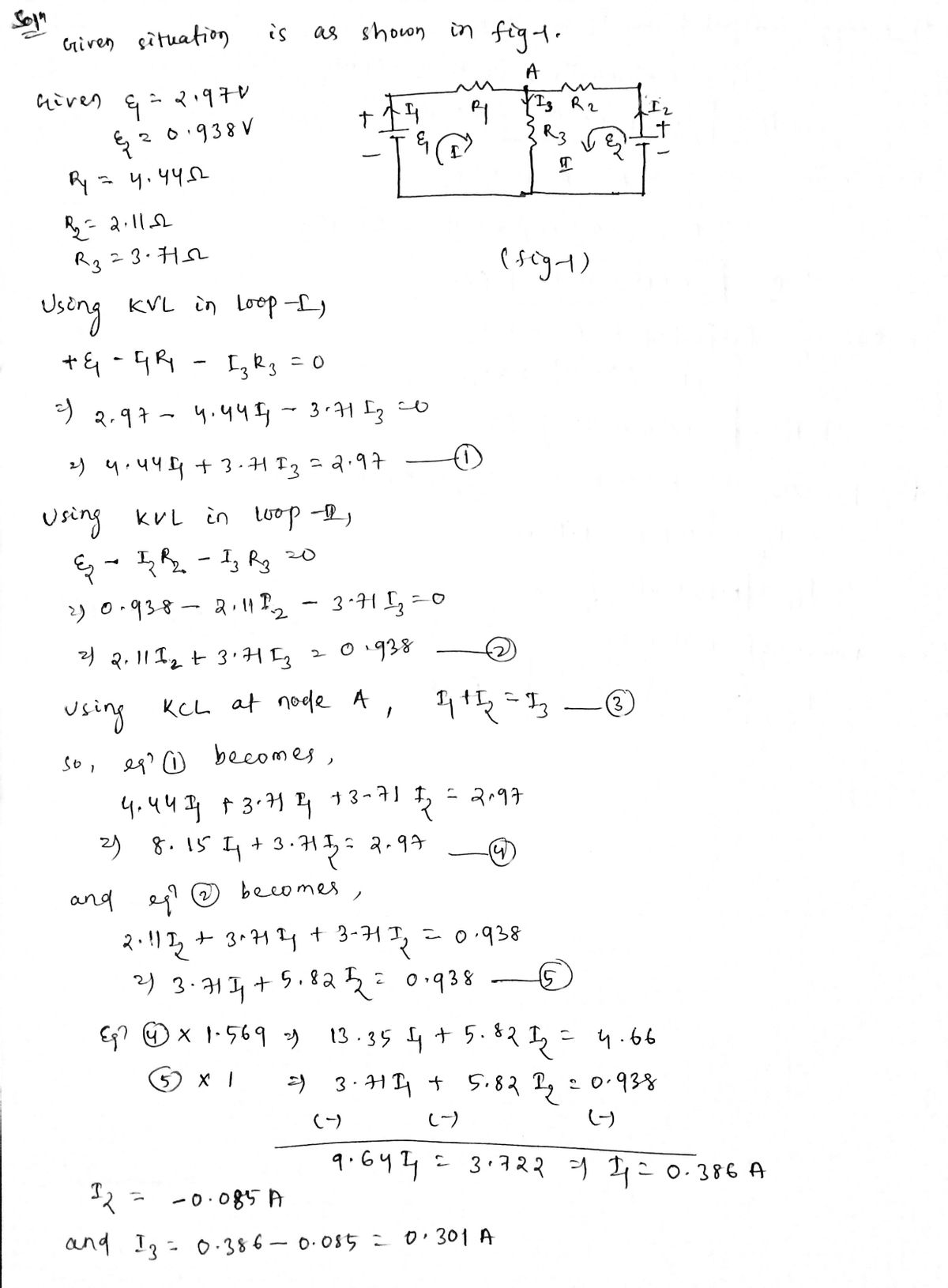In the figure &₁=2.97 V, 82 -0.938 V. R₁ = 4.44 02, R₂ = 2.110, R3-3.710, and both batteries are ideal. What is the rate at which energy is dissipated in (a) R₁. (b) R₂, and (c) R3? What is the power of (d) battery 1 and (e) battery 2?
In the figure &₁=2.97 V, 82 -0.938 V. R₁ = 4.44 02, R₂ = 2.110, R3-3.710, and both batteries are ideal. What is the rate at which energy is dissipated in (a) R₁. (b) R₂, and (c) R3? What is the power of (d) battery 1 and (e) battery 2?
Related questions
Question
![In the figure, \( \varepsilon_1 = 2.97 \, \text{V}, \varepsilon_2 = 0.938 \, \text{V}, R_1 = 4.44 \, \Omega, R_2 = 2.11 \, \Omega, R_3 = 3.71 \, \Omega \), and both batteries are ideal. What is the rate at which energy is dissipated in
- (a) \( R_1 \),
- (b) \( R_2 \), and
- (c) \( R_3 \)?
What is the power of
- (d) battery 1 and
- (e) battery 2?
---
**Diagram Description:**
The diagram shows a circuit with two batteries and three resistors. Battery \( \varepsilon_1 \) is connected in series with resistor \( R_1 \). The circuit branches into a parallel connection where resistor \( R_2 \) is in one branch and the series combination of resistor \( R_3 \) and battery \( \varepsilon_2 \) is in the other branch.
---
**Input Fields:**
- (a) Rate of energy dissipation in \( R_1 \): [Input field for number] [Dropdown for units]
- (b) Rate of energy dissipation in \( R_2 \): [Input field for number] [Dropdown for units]
- (c) Rate of energy dissipation in \( R_3 \): [Input field for number] [Dropdown for units]
- (d) Power of battery 1: [Input field for number] [Dropdown for units]
- (e) Power of battery 2: [Input field for number] [Dropdown for units]](/v2/_next/image?url=https%3A%2F%2Fcontent.bartleby.com%2Fqna-images%2Fquestion%2Fe8c7c5ce-a03a-4b82-b308-b170e9cd4a97%2Fa028e022-6db7-47e6-81f7-1b773bf843fc%2F0ql5kyn_processed.jpeg&w=3840&q=75)
Transcribed Image Text:In the figure, \( \varepsilon_1 = 2.97 \, \text{V}, \varepsilon_2 = 0.938 \, \text{V}, R_1 = 4.44 \, \Omega, R_2 = 2.11 \, \Omega, R_3 = 3.71 \, \Omega \), and both batteries are ideal. What is the rate at which energy is dissipated in
- (a) \( R_1 \),
- (b) \( R_2 \), and
- (c) \( R_3 \)?
What is the power of
- (d) battery 1 and
- (e) battery 2?
---
**Diagram Description:**
The diagram shows a circuit with two batteries and three resistors. Battery \( \varepsilon_1 \) is connected in series with resistor \( R_1 \). The circuit branches into a parallel connection where resistor \( R_2 \) is in one branch and the series combination of resistor \( R_3 \) and battery \( \varepsilon_2 \) is in the other branch.
---
**Input Fields:**
- (a) Rate of energy dissipation in \( R_1 \): [Input field for number] [Dropdown for units]
- (b) Rate of energy dissipation in \( R_2 \): [Input field for number] [Dropdown for units]
- (c) Rate of energy dissipation in \( R_3 \): [Input field for number] [Dropdown for units]
- (d) Power of battery 1: [Input field for number] [Dropdown for units]
- (e) Power of battery 2: [Input field for number] [Dropdown for units]
Expert Solution
Step 1

Step by step
Solved in 2 steps with 2 images
